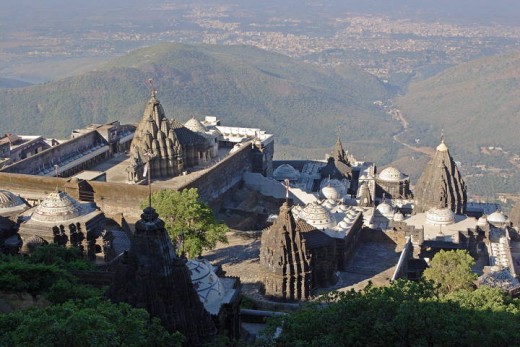The Great Jainism

The Great Religion, Jainism is founded by Rishabanath, the first Tirthankara of the religion. It's one of the ancient religions of India and dates back 1st century and quite differs from other religions by its unique principles and concepts. It preaches humans to love all living beings equally and do no harm to them. About 5 million people belong to this world spread religion.
Principles of Jainism
Jainism has belief in the equality of all living beings. It preaches to protect small living creatures such as insects and reptiles as every one contains the soul as humans have. And emphasizes the protection of all living beings in the world. It tells about the consequence of not only the physical activities and also of mental behaviors. Every one who belongs to Jainism is dedicated to human society to save Dharma (Justice) and they should preach the correct way of living for the benefits of all living beings.
Jain is said to be the follower of Jinas. Jinas means conquerors. The jains are in the belief of preaching of 24 prominent Jinas called Tirthankaras those who have discovered the way to salvation. The 24th Tirthankara is Mahaveer who had been lived from 599 to 527 BC
Jainism encourages the spiritual development by means of self control and personal wisdom. The goal is realization of soul's real nature. Jainism tells that Universe and Dharma (equality all living beings) have no ending and begining and there is no creator for this Universe. This religion quite differs from other religions by the concept of God. According to Jainism there is no supreme power of creating, destroying and preserving. The soul of every living being is potentially devine and the true followers of the religion who have completely eliminated their karmic bonding (activities), there by ending the cycle of birth and death, have attained Godly state.
History of the Religion
Kalinga (Orissa, India) had been the home for many jains in the past centuries. At that time, Rishabh, the first one of 24 Tirthankaras, was cordially worshipped and celebrated. The king Mahapadma Nanda who invaded Kalinga (Orissa, India) conquered the province of jains and also brought the statue of Rishabanath to his capital Magadha. However, in 1 st century the king Kharvela again conquered Magadha and brought Rishabanath's statue back and installed it in Udaygiri near his capital Shispalgath. Above said all historical events can be revealed by the Khandagiri and Udaygiri caves near Bhubaneswar, India which are only surviving stone monuments of Jainism.
The statues of 24 Tirthankaras

Who are Tirthankaras?
Tirthankaras, mean teachers, who had accomplished the highest spiritual goal of existence and then taught others how to achieve it. There have been 24 Tirthankaras in the history of Jainism. Among them first Tirthankara was Rishabanath who was also called as Abinath. It is said that they were born in the world to teach the way to moksha (paradise) or liberation. Tirthankara is not an incarnation of God and he is also an ordinary soul that was born to preach the humans correct path of life which leads to the state of God-consciousness. Though the Tirthankaras have been described as ordinary soul, they are also said as ultimate power developed state of soul.
Namokar Mantra of Jainism
This is the main prayer of Jainism which tells about the soul that have attained God-consciousness.
- Every living being in this world has a soul which can be considered as Godly thing.
- Every soul has great devine power with infinite knowledge and perception.
- Therefore we have to respect every living being as yourself and do no harm to them and learn to love them.
- Every soul takes birth as celestial, human and animal according to their karmas(activities)
- Every soul is responsible for it's future status and architect of it's own life.
- When soul is freed from karmas(activities), it will attain the state of God-consciousness with infinite power of knowledge and perception.
- Right view, Right knowledge and Right conduct are important things providing this way to reach the goal(Godly state).
- Non-violence(Ahimsa) is the basis of right view, the condition of right knowledge and right conduct.
- Controlling our senses and feeling of possessions will lead to a peaceful Godly life.
- Enjoying and giving importance to the company of Holy and Godly things will guide us to the ultimate spiritual enlightenment.
- Namokar Mantra advises every human being not to waste the life in evil things instead try to understand the ways which bring the spiritual enlightenment.
The jain temple at Ranakpur in India

The other jain temple on the Girnar hills of India

One of the beautiful jain temples in US

Influences of Jainism on other religions and its spread in India
Over several thousands of years Jainism has its influence on Hinduism. Majority of Hindu religious books describe about various Jain Tirthankaras and jain religion confirming historicity of Jainism from the period of Lord Rishabadev and India originally named after Bharat, the eldest son of First Tirthankara.
'Puja' is the commonly found spiritual activity in Hinduism which is the great influence of Jainism. 'Pu' means flower and 'ja' means offering. Puja is being cordially conducted in all the temples of Hinduism even today.
In India Maharashtra, Rajasthan and Gujarat have largest jain population. Karnataka, Madhya Pradesh and Punjab are having relatively large strength of jains in the country
Jainism in the world countries other than India
Jainism has been spread over many countries such as US, UK, Canada, Europe, Kenya, Tanzania and Uganda. The religion has its popularity in some parts of US and many Jain temples have been built there. Smaller Jain communities exist in Nepal, South Africa, Japan, Singapore, Malaysia, Australia, Fiji and Suriname.








